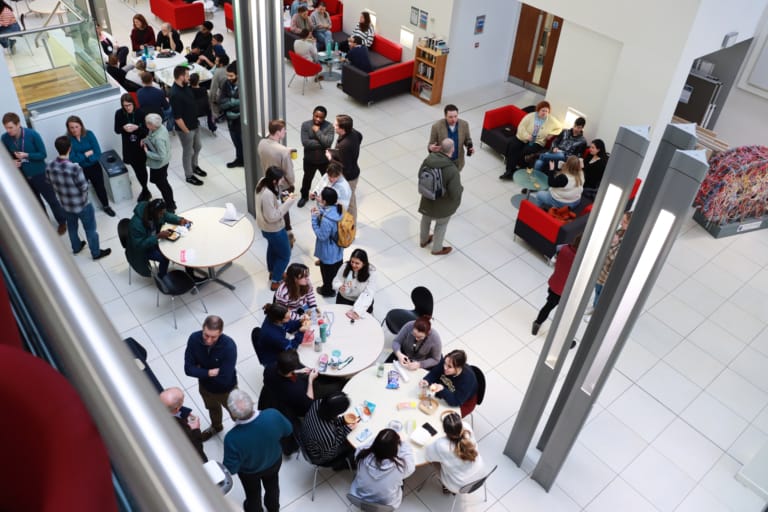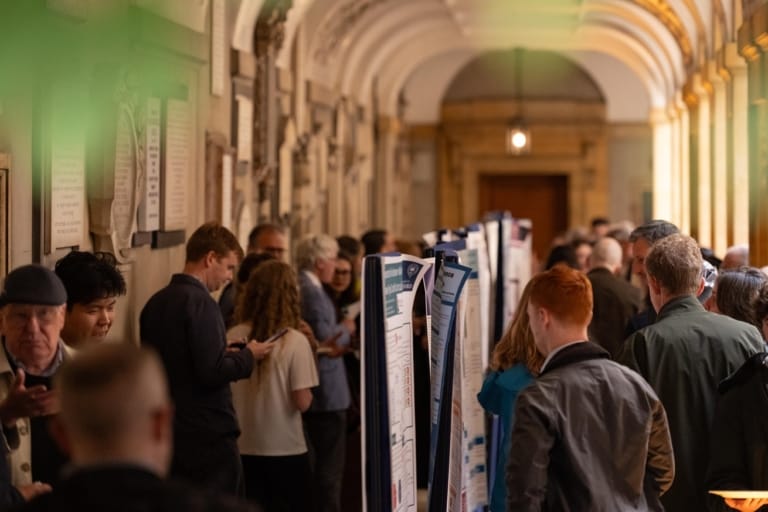Professor Madan Babu was awarded a Lister Prize in 2014 and has subsequently held fellowships at the Royal Society of Chemistry, Academy of Medical Sciences and most recently the Royal Society, which welcomed him as a member in 2023. He is the recipient of an EMBO Gold Medal, among many other accomplishments.
Madan spoke with us about his current work as Director of the Centre for Excellence for Data Driven Discovery at St Judes Children’s Research Hospital in the USA, his time as a Lister Fellow, and his views on the importance of community in science.
“We tend to think of biological entities as having fixed attributes, but what we find is that the only fixed attribute at all levels is variation.”
What’s the most exciting part of your work?
Conventionally, we think of the scientific process as starting with a question, then coming up with a testable hypothesis followed by experiments to validate it. In data science however, we are faced with huge amounts of data, and the answers are hidden somewhere within it. So, the challenge is asking the right questions and developing the right methods to tease out the signal from the noise. This is the part of the scientific process that I enjoy most.
Additionally, it’s privilege to work with highly-driven, outstanding colleagues with diverse expertise, which provides opportunities to learn something new every day. So really, it’s the process of scientific discovery and the people with whom we do it that are most exciting to me.
Your work explores the fundamental principles of life at micro and macro levels. What patterns can be seen at the atomic level?
The main pattern I observe in every living system, at every level, is variation. There is variation in everything. We tend to think of biological entities as having fixed attributes, but what we find is that the only fixed attribute at all levels is variation.
We observe variation in conformational dynamics at the single molecule level, expression variation at the cellular level, or genomic variation at the population level. Embracing variation and understanding its origins is critical as it can provide a framework to investigate biological systems and develop approaches to influence them.
What projects are you currently working on?
One of the main protein families we study is G Protein Coupled Receptors (GPCRs), a large, medically important group of proteins that respond to extracellular signals in a variety of ways, creating layers of signalling complexity.
We study this complexity at different levels, from atoms and ligands, to receptor conformation and expression in different cell types, to the physiological impact at the population level. The goal is to use the knowledge gained for translational applications and drug discovery. To do so, we develop data science approaches that we can adapt to study other medically relevant protein families, such as protein kinases, zinc finger domain containing transcription factors, and intrinsically disordered proteins.
What does community mean to you as a scientist?
A key attribute of any scientific society is the fact that it brings together individuals who are interested in a particular area of science. There is a society for chemistry, a society for genetics, a society for biochemistry, molecular biology, and so on. I have had the opportunity to be part of many different academic bodies, including the Lister Institute of Preventive Medicine, with many different focus areas.
Being a part of different societies teaches you how to think about a scientific problem from many different perspectives. Every society is also a community in its own sense because it brings together people with common interests who may face similar challenges in their scientific pursuits.
It’s great to see how the different societies push scientists to address problems, pursue goals and make progress by embracing diverse challenges and approaching them in many ways. That way, you learn from one society to another, and this makes you more creative in pushing the frontiers of science.
So, what a community means to me is an opportunity to meet individuals with shared interests, learn from each other, and work together towards progressing a common objective, be it the frontiers of science or bringing the knowledge of what we learn from science to society.
“The Annual Meetings allowed me to bring my summer students and summer interns who were supported by the Lister Institute, so we had three or more generations of scientists together.”
What impact has the Lister Fellowship and Lister Prize had on your career?
I was very fortunate to be part of the Lister Institute for Preventative Medicine while starting my career as a group leader at the MRC LMB (Medical Research Council Laboratory of Molecular Biology).
Being part of the Lister Institute made me realize the importance of performing scientific research with a translational impact in mind. Given that my interests have been in understanding the basic molecular biological mechanisms by which cells operate, being able to encounter, interact and meet with other Fellows who are primarily physician-scientists opened my eyes to how discoveries can really impact medicine.
More importantly, it helped me identify, amongst the complexity of the physiological processes that physicians encounter when treating patients, what fundamental molecular questions need to be answered. That allowed me to dig deeper into specific areas of biology.
You can view this as a bottom-up scientist encountering top-down scientists. When you work from the bottom up it’s very easy to get lost, not knowing whether what you’re studying really is important. But if you marry the top-down and bottom-up approaches you can quickly identify synergies between them and ask questions with the right physiological impact.
I think it’s this experience from the Lister Fellowship that has had the biggest impact on my own career. It has helped me identify the right questions and the right components of the question with potential translational impact, which may ultimately benefit society. That was also one of the things that motivated me move to St. Jude Children’s Research Hospital.
Would you say that the Lister was your first exposure to physician-scientists?
Lister was one of the first opportunities in my academic career that brought me in touch with so many physician-scientists. It was so stimulating to meet with them – they see patients, and at the same time, do cutting-edge research. That combination in the same individual was inspiring.
“Being a part of different societies teaches you how to think about a scientific problem from many different perspectives.”
What is your best memory from your time as a Lister Fellow?
Some of my best memories are of the annual meetings that bring together current and past Lister Fellows. It was always an outstanding day of exciting science. Addressing diverse topics with amazing new insights, and discussing almost exclusively unpublished work, really provided a lot of opportunities for scientific interactions and potential collaborations. I also very fondly remember seeing faculty members enthusiastically presenting their findings in the poster sessions.
It is wonderful to have, in one place, so many different backgrounds represented by the different Fellows, and to engage in scientific discussions on the same topic but from diverse perspectives. It enriches your own understanding of the problems and helps identify the real implications of the discovery you are presenting. Through this process I met several senior colleagues who have become mentors in my scientific career.
The Annual Meetings allowed me to bring my summer students and summer interns who were supported by the Lister Institute, so we had three or more generations of scientists together. There were the young undergraduate students, early-career scientists who had just finished their postdocs and were perhaps making their first foray into being independent, recent past Fellows who had made the transition to mid-career scientists, and long-term members of the Lister Institute who have institutional memory and historical knowledge that provide context to the many initiatives of the organization.
All these things make the Lister Annual Meetings extremely special.Learn more about Madan’s work



